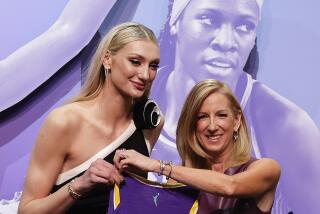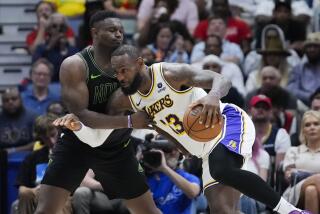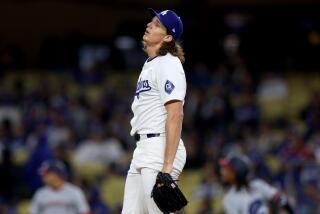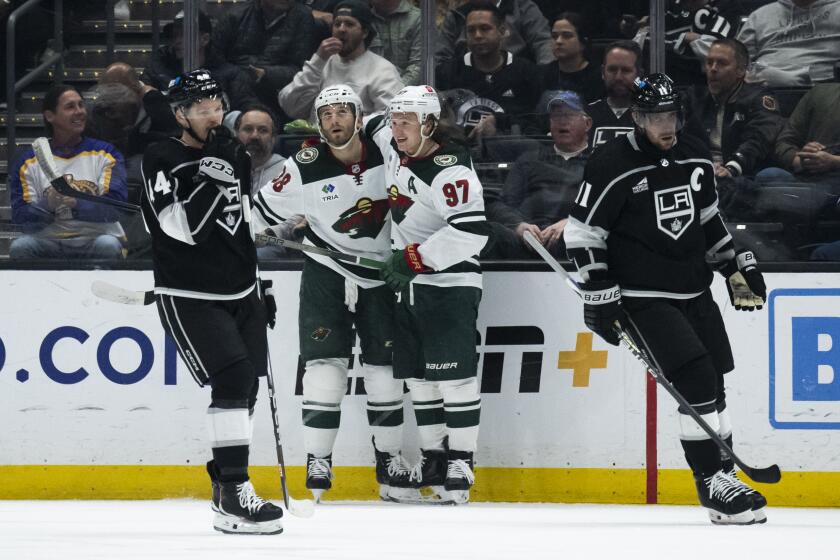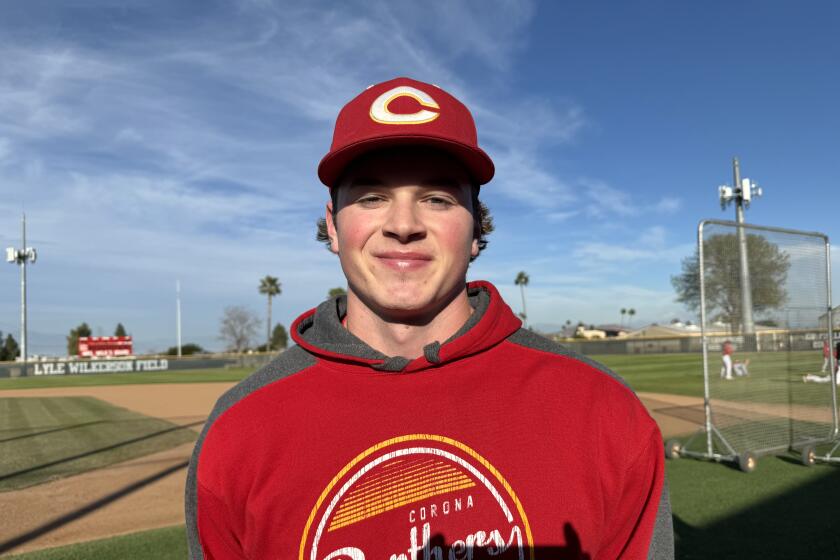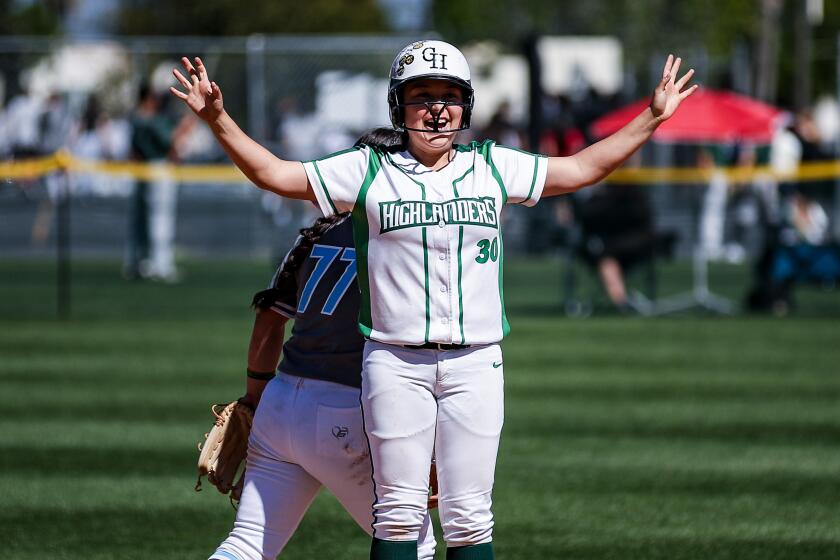History of Pro Football in Los Angeles
1920
The American Professional Football Assn.--to be renamed the National Football League in 1922--is founded with 14 teams, none west of Illinois.
For the record:
12:00 a.m. March 18, 1999 For the Record
Los Angeles Times Thursday March 18, 1999 Home Edition Sports Part D Page 8 Sports Desk 1 inches; 29 words Type of Material: Correction
Pro football--The Rams traded nine players in 1959 to the Chicago Cardinals for Ollie Matson. The name of the Cardinal player was incorrect in a chart on the history of pro football in Los Angeles on Wednesday.
1926
A January exhibition game featuring Red Grange against a team of college all-stars calling themselves the Los Angeles Tigers draws a crowd of 75,000 to the Coliseum, to that point a pro football record.
For one season, Los Angeles has two pro football teams--the NFL Buccaneers and the Wildcats of the newly formed American Football League--although neither team plays in Los Angeles. With USC lobbying successfully to ban pro football from the Coliseum, both the Buccaneers and the Wildcats are Los Angeles in name only, playing strictly on the road. Travel-weary, the Buccaneers finish 6-3-1 and fold, the Wildcats finish 6-6-2 and the AFL folds.
1937
In its second year of existence, the second American Football League grants membership to the minor league powerhouse Los Angeles Bulldogs--thereby making the ‘Dogs the first “major league” sports team to actually play in Los Angeles. With home games at Gilmore Stadium, the Bulldogs’ wide-open offense routs the rest of the AFL field so thoroughly, the league folds at season’s end. The Bulldogs finish their only AFL season 9-0, having outscored opposing teams, 233-72, and return to the minor league ranks.
1946
Pro football returns to Los Angeles--twice. Citing financial difficulties in Cleveland, Ram owners Dan Reeves and Fred Levy move their team to Los Angeles. A rival league, the All-American Football Conference, begins play with teams in eight cities, one of them Los Angeles. The AAFC Los Angeles entry is named the Dons after owner-actor Don Ameche. Both teams play their home games at the Coliseum.
The Rams draw 68,188 to their first game at the Coliseum, a 16-14 victory over Washington, and finish the season 6-4-1. The Dons go 7-5-2, placing third in the AAFC’s four-team West Division.
1947
Both Los Angeles teams break even--the Rams at 6-6, the Dons at 7-7. The Dons double their 1946 home attendance total, but still lose money.
1949
Rams win the Western Conference title for the first time in Los Angeles with an 8-2-2 record. In a harbinger of playoff heartbreaks to come, the Rams lose the NFL championship in monsoon conditions in Philadelphia, 14-0, as quarterbacks Bob Waterfield and Norm Van Brocklin combine to complete 10 of 27 passes for 98 yards.
Obscured by the Rams’ playoff run, the Dons are abandoned by the fans and the media as they slump to 4-8. After the season, three AAFC franchises--the Browns, the 49ers and the Baltimore Colts--are absorbed by the NFL while the remaining five teams fold.
1950
Rams set league records for points (466), touchdowns (64) and points in a single game (70, vs. Baltimore) en route to a second consecutive conference championship. They return to Cleveland to face the Browns for the NFL title, and for more heartbreak--they blow an eight-point fourth-quarter lead and watch Lou Groza kick the decisive field goal with 28 seconds left. Final score: Browns 30, Rams 28.
1951
Rams win their first, and only, NFL championship in Los Angeles. With Elroy Hirsch setting league records for touchdown catches (17) and receiving yards (1,495), the Rams win the National Conference at 8-4, then beat Cleveland for the NFL title, 24-17, before a Coliseum crowd of 59,475 on Dec. 23.
1952
Rams trade 11 players to the Dallas Texans for rookie linebacker Les Richter, who promptly enlists in the Army for a two-year hitch. Dick (Night Train) Lane, a walk-on rookie defensive back, intercepts an NFL-record 14 passes--and fails to make the Pro Bowl. Rams finish in a first-place tie with Detroit at 9-3, but lose National Conference playoff to the Lions, 31-21, when Bobby Layne--and the fog?!--rolls into the Coliseum.
1955
Before 87,695 at the Coliseum, the Rams lose another NFL title game to the Browns, 38-14, as Otto Graham scores two touchdowns and passes for two more in the final game of his career.
1959
Rams trade nine players to the Chicago Cardinals for four-time All-Pro running back Marion Motley, but coaching staff can’t decide where to play Motley--halfback, fullback, flanker, split end or defensive back? When Rams finish in last place at 2-10, Coach Sid Gillman is fired, just in time to hook up with the Los Angeles entry in the new American Football League.
1960
The Los Angeles Chargers begin life in the AFL sharing space, but not fan affection, with the 4-7-1 Rams. Behind a high-powered offense led by quarterback Jack Kemp, Gillman’s Chargers win the Western Division at 10-4 and beat Denver, 41-33, to qualify for the first AFL title game. But only 9,928 show up at the Coliseum for the semifinal victory over Denver, prompting the league to move the site of the final from Los Angeles to Houston. There, the Chargers lose to the Oilers, 24-16, on an 88-yard fourth-quarter pass from George Blanda to Billy Cannon.
1961
Citing first-year losses of $900,000, Charger owner Barron Hilton moves his team to San Diego, where they will win the AFL title in 1963.
1966
Rams go to court to wrest assistant coach George Allen away from the Chicago Bears and name him their head coach. Allen installs Roman Gabriel as starting quarterback, brings in linebacker Maxie Baughan, talks Jack Pardee out of retirement and prods Rams to their first winning season since 1958 at 8-6.
1967
Reserve linebacker Tony Guillory blocks a fourth-quarter punt against Green Bay and the Rams rally to upset the defending NFL champion Packers, 27-24, at the Coliseum en route to an 11-1-2 record and the Coastal Division title. When the teams meet again in the playoffs, the site is Lambeau Field and the Rams freeze up in a 28-7 defeat.
1968
After the Rams finish second in the Coastal Division at 10-3-1 behind the 13-1 Colts, Reeves fires Allen. When Ram veterans rally behind Allen in protest of the decision, Reeves calls a press conference to introduce the new coach: George Allen.
1969
Rams win their first 11 games to clinch the Coastal Division title, then Allen begins benching key veterans to “rest” them for the playoffs. Rams proceed to lose their last three regular-season games, as well as the home-field playoff advantage to Minnesota. There, the Rams blow a 20-14 fourth-quarter lead and lose to Wobblin’ Joe Kapp and the Vikings, 23-20.
1970
Reeves, dying of cancer, fires Allen again and this time sticks with the decision--despite Allen’s 49-17-4 record with the Rams.
1971
Reeves dies in April. Longtime business associate William Barnes takes over as team president. Willie Ellison rushes for a league-record 247 yards against New Orleans, but Rams miss the playoffs by half a game.
1972
Robert Irsay buys the Rams for $19 million and, in the biggest trade in football history, swaps them for the Colts and $3 million. New Rams owner Carroll Rosenbloom fires Coach Tommy Prothro after a 6-7-1 season.
1973
Rams hire an obscure Detroit Lion assistant named Chuck Knox as head coach, trade Gabriel to Philadelphia for wide receiver Harold Jackson and replace Gabriel with San Diego quarterback John Hadl. Hadl-to-Jackson becomes the scourge passing combination of the NFL as the Rams win the NFC West at 12-2. Knox is NFL coach of the year, Hadl is NFC player of the year--but the Rams go out in the first round of the playoffs in Dallas, 27-16.
1974
The World Football League debuts with 12 teams--including Anaheim’s Southern California Sun--beginning regular season in July. Coached by former Ram receiver Tom Fears and clad in the unprecedented color scheme of magenta and orange, the Sun wins the Western Division title at 13-7, but loses to Hawaii in the divisional playoffs, 32-14.
Rams are preseason Super Bowl favorites, but after a 3-2 start, the front office grows impatient and trades Hadl to Green Bay for five draft choices. James Harris replaces Hadl, becoming one of the first black quarterbacks to play regularly in the NFL, and leads the Rams to first place in the NFC West at 10-4. Rams lose the NFC title game, 14-10, at Minnesota after guard Tom Mack is whistled for motion with the ball six inches from the the Viking goal line--and Harris is intercepted in the end zone two plays later.
1975
Sun is first in the WFL’s West Division again at 7-5 when the league ceases operations with seven games left in the regular season.
Rams win the NFC West again at 12-2, lose the NFC title game again--this time at home to the wild-card Dallas Cowboys, 37-7.
1976
Rams win a fourth consecutive NFC West title and suffer a third consecutive defeat in the NFC final--24-13 at Minnesota after Knox opts for a field goal on fourth-and-goal from the Viking one and Tom Dempsey’s chip shot is blocked by Nate Allen and returned 90 yards for a Minnesota touchdown by Bobby Bryant.
1977
Rams win a fifth consecutive division title and lose again to Minnesota in the playoffs, this time at home, in a Coliseum downpour, 14-7. Before Rosenbloom can fire him, Knox resigns and signs to coach the Buffalo Bills.
1978
Rams re-hire Allen as head coach, saying thanks but no thanks to runner-up Bill Walsh. Two combustible personalities, Allen and Rosenbloom coexist long enough for Allen to coach two preseason games--then Rosenbloom fires him. Assistant Ray Malavasi takes over as head coach, Rams go 12-4 to win their sixth consecutive NFC West title, lose again to Dallas in the NFC title game, 28-0.
Rams and the city of Anaheim announce plans for the Rams to move their home games to Anaheim Stadium beginning in 1980.
1979
Rosenbloom drowns in a swimming accident in Florida on April 2. His will leaves 70% controlling interest of the Rams to his wife, Georgia.
With seemingly their weakest squad since 1972, the Rams reach their first and only Super Bowl. Rams lose their final game at the Coliseum, 29-14, to finish the regular season 9-7. But they upset the Cowboys in Dallas in the first round of the playoffs, 21-19, and scrape past Tampa Bay in the NFC final, 9-0, on three Frank Corral field goals. In Super Bowl XIV at the Rose Bowl, the Rams, prohibitive underdogs to the three-time champion Pittsburgh Steelers, take a 19-17 lead into the fourth quarter. Then, John Stallworth outleaps tiny defensive back Rod Perry for a 73-yard touchdown bomb and the Steelers go on to win, 31-19.
1980
Rams move to Anaheim and immediately lose their grip on the NFC West, finishing out of first place for the first time since 1972 and losing wild-card game to Dallas, 34-13.
Unable to reach a new stadium agreement in Oakland, Raider owner Al Davis announces he is moving his team to Los Angeles. When NFL owners vote to deny the move, Davis sues the league, citing violation of federal antitrust laws. Raiders defeat Philadelphia in Super Bowl XV, 27-10.
1981
The Raiders’ antitrust lawsuit against the NFL is declared a mistrial after the jury fails to reach a unanimous decision. A new trial is scheduled for the spring of 1982.
1982
Raiders win the re-trial, are free to move to Los Angeles and do--practicing in Oakland and flying in for “home” games at the Coliseum. Commuter Raiders win the AFC West title with an 8-1 record in a strike-shortened season and reach the AFC semifinal, where they blow a 14-10 fourth-quarter lead and lose to the New York Jets, 17-14, before a Coliseum crowd of 90,688.
1983
Los Angeles’ brief existence as a three-team pro football town begins with the Raiders winning the Super Bowl, Ram tailback Eric Dickerson setting the NFL rookie rushing record with 1,808 yards and the U.S. Football League’s Express debuting with an 8-10 record.
Marcus Allen rushes for 191 yards and two touchdowns as the Raiders rout Washington, 38-9, in Super Bowl XVIII, giving Los Angeles its second NFL championship.
After hiring coach John Robinson from USC and drafting Dickerson from Southern Methodist, the Rams return to the playoffs at 9-7 but hit the wall in the second round, splattered by Washington, 51-7.
1984
After purchasing the Express from original owner Bill Daniels, Bill Oldenburg agrees to pay BYU quarterback Steve Young $40 million through the year 2027. Young leads the Express to a 10-8 record and a 27-21 playoff victory over Michigan in three overtimes--the longest professional football game ever played. But Arizona, coached by George Allen, ends the Express’ season in the next round, 35-23.
Dickerson breaks O.J. Simpson’s single-season NFL rushing record with 2,105 yards as the Rams go 10-6 to earn another wild card behind 15-1 San Francisco. Rams lose the wild card game at home to New York, 16-13.
1985
With Oldenburg under federal indictment, the USFL assumes control of the Express. The team finishes its final season at 3-15, playing its last home game at Pierce College in Woodland Hills. The league announces plans for a 1986 fall season, minus the Express, but never plays another game.
Both the Rams and the Raiders win their respective divisional titles, with the Rams advancing to the NFC final. There, the Rams lose to Chicago, 24-0, as quarterback Dieter Brock spends most of the day flinging footballs into sideline snow drifts at Soldier Field. The Raiders lose at home in the divisional playoffs, 27-20 to New England.
1986
Dickerson rushes for 1,821 yards, but the Rams lose their last two regular-season games to finish second in the NFC West at 10-6--and then lose the wild-card game to Washington, 19-7.
1987
Davis strikes a deal with the city of Irwindale, agreeing to move the Raiders there beginning with the 1991 season. The Coliseum Commission sues Davis for breach of contract. Davis countersues.
Raiders lose seven games in a row, their longest losing streak since 1962. Bo Jackson joins the team in midseason, but the Raiders proceed to finish 5-10 and in fourth place. Coach Tom Flores resigns at the end of the season.
In the midst of his annual salary dispute with Ram management, Dickerson demands a trade and on Halloween, the club obliges him--sending him to the Indianapolis Colts for Greg Bell, Owen Gill and six draft choices. Rams finish 6-9, Robinson’s first losing season as a head coach.
1989
The February deadline for the Raiders to finalize a deal with Irwindale passes. The Raiders remain in the Coliseum, Davis pockets $10 million for his “consideration” of the Irwindale offer.
In their most exciting season since the early 1950s, the Rams stage several fourth-quarter rallies to finish 11-5 and earn another wild card. Flipper Anderson sets an NFL record with 336 receiving yards during one comeback against New Orleans. In the playoffs, the Rams win on the road against Philadelphia and New York, setting up an NFL final matchup with the rival 49ers. The game is no contest; quarterback Jim Everett sacks himself in the second half--the now- infamous “Phantom Sack”--and the Rams are thrashed, 30-3.
After a 1-3 start, the Raiders fire Coach Mike Shanahan and replace him with former All-Pro lineman Art Shell, who becomes the NFL’s first black head coach. Raiders finish 8-8.
1990
On March 13, Davis announces he’s moving the Raiders back to Oakland, agreeing to accept Oakland Mayor Lionel Wilson’s most considerate offer of $602 million--plus a guarantee of 15 years of sellouts. Taxpayer revolt in Oakland eventually causes Wilson to revise the proposal: $127 million with no sellout guarantee. Davis decides to pass and signs an extension with the Coliseum Commission.
Shell is named NFL coach of the year as the Raiders reclaim the AFC West championship at 12-4. But they lose the AFC title game to Buffalo, 51-3--yielding a record 41 points in the first half.
1991
Raiders reach the playoffs at 9-7 on the strength of their kicking game and little more. A rookie, Todd Marinovich, starts at quarterback in the wild-card game against Kansas City and throws four interceptions in a 10-6 defeat.
Rams collapse, finishing 3-13 as Everett throws 20 interceptions and the defense gives up a league-high 390 points. Robinson resigns days before the Rams’ final regular-season game.
1992
Forgetting that you can never go home again, the Rams rehire Knox as head coach. Good news: Knox doubles the team’s victory total. Bad news: That still leaves the Rams in last place at 6-10.
Raiders go through three quarterbacks--Jay Schroeder, Marinovich and the perennial Vince Evans--before deciding none of them is good enough. They finish 7-9.
1993
Raiders trade Allen to Kansas City, where he scores 15 touchdowns and is named NFL comeback player of the year. A better transaction is the acquisition of New York Giant quarterback Jeff Hostetler, who passes for 3,242 yards to lead the Raiders back to the playoffs at 10-6. Raiders beat Denver in the first round, 42-24, but lose in the second to Buffalo on a late touchdown pass from Jim Kelly to Bill Brooks, 29-23.
Jerome Bettis rushes for 1,429 yards and is named NFL offensive rookie of the year, but Rams still place last in the NFC West at 5-11.
1994
Amid rumors that both teams are set to leave town, the Rams and the Raiders mark the occasion by failing to qualify for the playoffs. After trading Everett to New Orleans and trying to replace him with two quarterbacks named, rather ironically, Chris (Miller and Chandler), the Rams go 4-12 and Knox is fired at season’s end. The Raiders, hit by an NFL record 156 penalties, place third in the AFC West at 9-7 and also fire their coach, replacing Shell with Mike White. In what will be their last home games in Los Angeles, the Rams lose to Washington, 24-21, and the Raiders lose to Kansas City, 19-9.
1995
Within a span of three months, Los Angeles’ NFL roster is trimmed from two teams to none. On April 12, NFL owners vote to approve the Rams’ move to St. Louis. On July 12, owners vote to approve the Raiders’ return to Oakland. For the first time since 1945, Los Angeles is devoid of professional football.
More to Read
Get our high school sports newsletter
Prep Rally is devoted to the SoCal high school sports experience, bringing you scores, stories and a behind-the-scenes look at what makes prep sports so popular.
You may occasionally receive promotional content from the Los Angeles Times.
